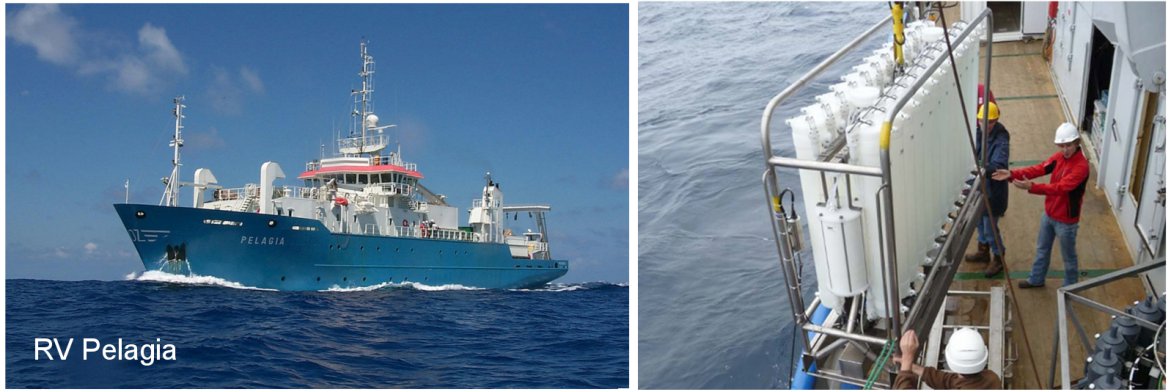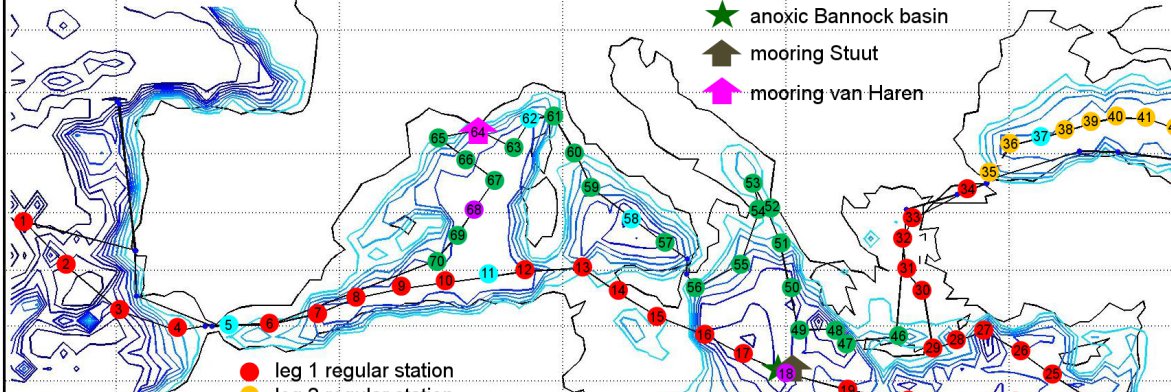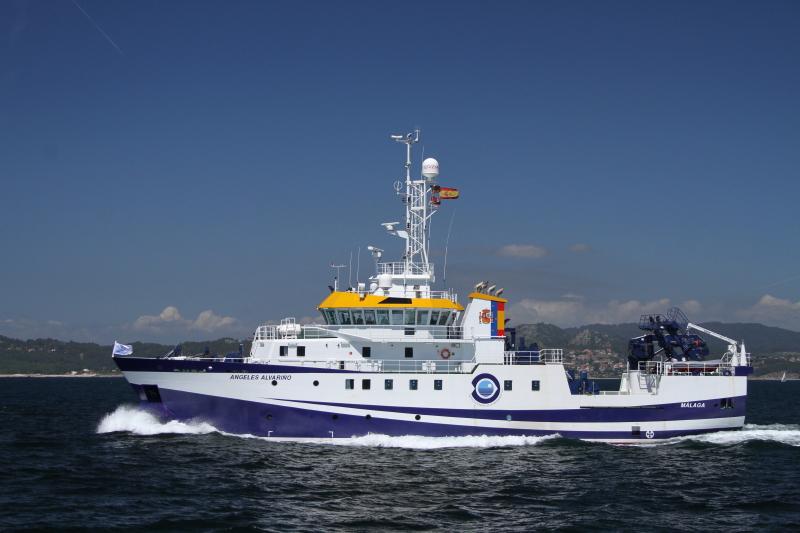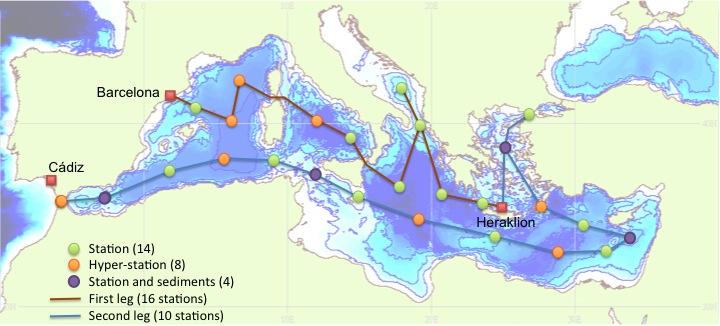Mediterranean and Black Sea GEOTRACES section (GA04) will be realized in 2013, thanks to a Netherland-Spanish cooperation
GEOTRACES: The Mediterranean Section GA04
The GEOTRACES Mediterranean Section (GA04) will be realized thanks to a collaboration between Netherlands and Spain. Samples will be collected from the first of May until the mid of August, on two oceanic research vessels: the Pelagia (GA04-N) and the RV /Ángeles Alvariño (GAO4-S).
Both cruises are described below
MEDBLACK, Section GA04-N
MEDBLACK: RV Pelagia in the Mediterranean Sea and the Black Sea
The objective is to elucidate important biogeochemical processes, sources and sinks that determine the distribution of bio-essential and other trace elements in the Mediterranean Sea and Black Sea. As dust is a main transport pathway of bio-essential trace elements to the surface of the open ocean the heavy Saharan dust impact on the Mediterranean Sea is ideal to investigate the effect of dust on the biogeochemical cycles of trace elements and isotopes. The Black Sea is the largest anoxic basin of the world and forms an ideal natural laboratory to unravel the microbial driven reduction and oxidation reactions of trace elements and isotopes.
Scientists on the NIOZ research vessel Pelagia will take samples to determine the distribution of the GEOTRACES TEIs and many other trace elements that necessitates trace metal clean sampling (Figure 1). A large volume non trace metal clean CTD system allows for sampling of many additional parameters. The cruise is cooperating with the Geotraces program to cover the section GA04, in combination with a UAB cruise on board the RV Ángeles Alvariño (GA04-S).
Figure 1. The Dutch research vessel Pelagia and the PRISTINE® sampler (made of ultrapure PVDF and titanium)
Click on the image to view it in high resolution
The cruise track of the RV Pelagia will cover the whole Mediterranean basin as well as the Black Sea and is divided over three legs, figure 2.
Figure 2. The cruise track of RV Pelagia in the Mediterranean Sea and the Black Sea in 2013.
Click on the image to view it in high resolution
The RV Pelagia will leave the island of Texel (The Netherlands) on 7 May 2013 and sail to Lisbon (Portugal) where it arrives 15 May. The first MEDBLACK leg starts 16 May from Lisbon and will sample 4 stations in the northeast Atlantic Ocean followed by a long west to east section in the southern Mediterranean Sea with a final port call in Istanbul (Turkey) on 6 June. Research leg 2 departs from Istanbul on 12 July for a 9 days research cruise in the Black Sea. Research leg 3 leaves Istanbul on 22 July to sample stations in the south Adriatic and then west off Italy into the Gulf of Lyon with a final port call in Lisbon on 11 August.
Information:
Cruise ID: 64PE370
Research vessel: RV Pelagia
Period (arrival and departure date): May 7th to August 11th 2013
Port of Departure: Texel ( the Netherlands)
Port of return: Lisbon
Chief scientist: Micha Rijkenberg
GEOTRACES scientist:Hein de Baar/Micha Rijkenberg
GEOTRACES section: : GA04 -N
MedSeA – GA04-S
RV Ángeles Alvariño
The MedSeA – GA04-S oceanographic cruise is an essential part of the European project Mediterranean Sea Acidification in a changing climate (MedSeA, medsea-project.eu) and the Geotraces program. It is coordinated by the Universitat Autònoma de Barcelona (UAB). In the frame of the EU MedSeA project, one of the principal objectives is to address questions related to the chemical and biological response of the Mediterranean Sea carbonate chemistry to the ongoing anthropogenic CO2 emission. The characteristics of the Mediterranean Sea are such that it has the potential to sequester large amounts of anthropogenic CO2. It has, indeed, very high water column inventories of anthropogenic CO2, however, few carbon data exist in the Mediterranean Sea, and very little is known about the impact on the pelagic ecosystems.
On the other hand, the cruise is cooperating with the Geotraces program to cover the section GA04, in combination with a NIOZ cruise on board the Pelagia (GA04-N). Both cruises will take samples to determine the distribution of the GEOTRACES TEIs and many other parameters. While Pelagia will focus on trace element sampling that necessitates trace metal clean sampling system, Ángeles Alvariño will collect those samples that require large volumes of water.
Figure 1. The Spanish research vessel Ángeles Alvariño.
Click on the image to view it in high resolution
The cruise track of the RV Ángeles Alvariño will cover the whole Mediterranean basin and is divided over two legs, Figure 2.
Figure 2. The cruise track of RV Ángeles Alvariño in the Mediterranean May 2013.
Click on the image to view it in high resolution
The RV Ángeles Alvariño will depart Cadiz (Spain) on 2 May 2013 and will cover 16 stations on the first leg in the southern Mediterranean Sea. After the first leg, approximately on May 18th, the cruise will enter the harbor of Heraklion (Crete, Greece). The second leg will start on May 19th and cover the northern Mediterranean Sea. During the cruise we will collect water samples at 26 stations. We also plan to collect sediments and perform incubation experiments at 4 selected stations.
Information:
Cruise ID: MedSeA-GA04-S
Research vessel: Ángeles Alvariño
Period (arrival and departure date): May 2nd to June 1st 2013
Port of Departure: Cadiz
Port of return: Barcelona
Chief scientist: Patrizia Ziveri
GEOTRACES scientist: Jordi Garcia-Orellana
GEOTRACES section: GA04-S




